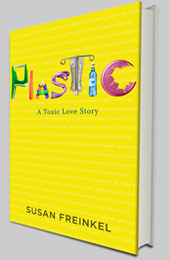plastic

Excerpt
I decided to go an entire day without touching anything plastic. The absurdity of this experiment became apparent about ten seconds into the appointed morning when I shuffled bleary-eyed into the bathroom: the toilet seat was plastic. I quickly revised my plan. I would spend the day writing down everything I touched that was plastic.
Within forty-five minutes I had filled an entire page in my Penway Composition Book (which itself had to be cataloged as partly plastic, given its nylon binding, as did my well-sharpened no. 2 pencil, which was coated with yellow paint that contained acrylic). Here’s some of what I wrote down as I made my way through my early-morning routine:
Alarm clock, mattress, heating pad, eyeglasses, toilet seat, toothbrush, toothpaste tube and cap, wallpaper, Corian counter, light switch, tablecloth, Cuisinart, electric teakettle, refrigerator handle, bag of frozen strawberries, scissors handle, yogurt container, lid for can of honey, juice pitcher, milk bottle, seltzer bottle, lid of cinnamon jar, bread bag, cellophane wrapping of box of tea, packaging of tea bag, thermos, spatula handle, bottle of dish soap, bowl, cutting board, baggies, computer, fleece sweatshirt, sports bra, yoga pants, sneakers, tub containing cat food, cup inside tub to scoop out the kibble, dog leash, Walkman, newspaper bag, stray packet of mayo on sidewalk, garbage can.
“Wow!” said my daughter, her eyes widening as she scanned the rapidly
growing list.
By the end of the day I had filled four pages in my notebook. My rule was to record each item just once, even those I touched repeatedly, like the fridge handle. Otherwise I could have filled the whole notebook. As it was, the list included 196 entries, ranging from large items, like the dashboard of my minivan—really, the entire interior—to minutiae, like the oval stickers adorning the apples I cut up for lunch. Packaging, not surprisingly, made up a big part of the list.
I’d never thought of myself as having a particularly plastic-filled life. I live in a house that’s nearly a hundred years old. I like natural fabrics, old furniture, food cooked from scratch. I would have said my home harbors less plastic than the average American’s—mainly for aesthetic reasons, not political ones. Was I kidding myself? The next day I tracked everything I touched that wasn’t made of plastic. By bedtime, I had recorded 102 items in my notebook, giving me a plastic/nonplastic ratio of nearly two to one. Here’s a sample from the first hour of the day:
Cotton sheets, wood floor, toilet paper, porcelain tap, strawberries, mango, granite-tile countertop, stainless steel spoon, stainless steel faucet, paper towel, cardboard egg carton, eggs, orange juice, aluminum pie plate, wool rug, glass butter dish, butter, cast-iron griddle, syrup bottle, wooden breadboard, bread, aluminum colander, ceramic plates, glasses, glass doorknob, cotton socks, wooden dining-room table, my dog’s metal choke collar, dirt, leaves, twigs, sticks, grass (and if I weren’t using a plastic bag, what my dog deposited amid those leaves, twigs, and grass).
Oddly, I found it harder and more boring to maintain the nonplastic list. Because I’d pledged not to count items more than once, after the first flood of entries, there wasn’t that much variety—at least not when compared with the plastics catalog. Wood, wool, cotton, glass, stone, metal, food. Distilled further: animal, vegetable, mineral. Those basic categories pretty much encompassed the items on the nonplastic list. The plastic list, by contrast, reflected a cornucopia of materials, a dazzling variety of the synthetica that has come to constitute such a huge, and yet strangely invisible, part of modern life.
Pondering the lengthy list of plastic in my surroundings, I realized I actually knew almost nothing about it. What is plastic, really? Where does it come from? How did my life become so permeated by synthetics without my even trying?

